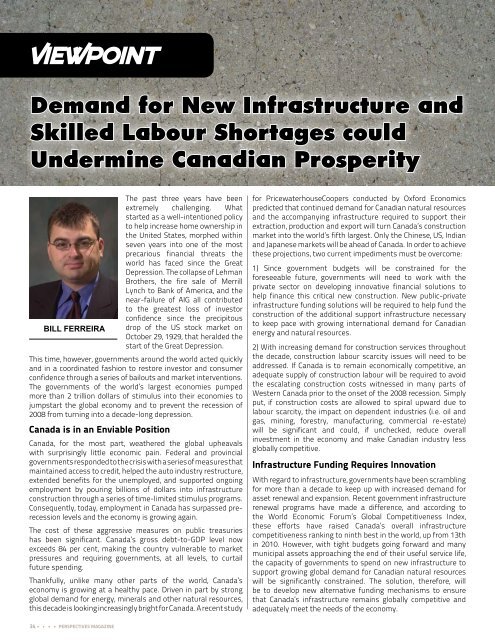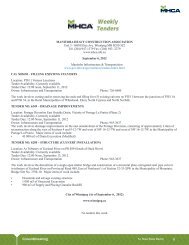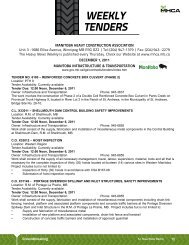2012 Perspectives Magazine - Manitoba Heavy Construction ...
2012 Perspectives Magazine - Manitoba Heavy Construction ...
2012 Perspectives Magazine - Manitoba Heavy Construction ...
Create successful ePaper yourself
Turn your PDF publications into a flip-book with our unique Google optimized e-Paper software.
viewpoint<br />
Demand for New Infrastructure and<br />
Skilled Labour Shortages could<br />
Undermine Canadian Prosperity<br />
bill ferreira<br />
The past three years have been<br />
extremely challenging. What<br />
started as a well-intentioned policy<br />
to help increase home ownership in<br />
the United States, morphed within<br />
seven years into one of the most<br />
precarious financial threats the<br />
world has faced since the Great<br />
Depression. The collapse of Lehman<br />
Brothers, the fire sale of Merrill<br />
Lynch to Bank of America, and the<br />
near-failure of AIG all contributed<br />
to the greatest loss of investor<br />
confidence since the precipitous<br />
drop of the US stock market on<br />
October 29, 1929, that heralded the<br />
start of the Great Depression.<br />
This time, however, governments around the world acted quickly<br />
and in a coordinated fashion to restore investor and consumer<br />
confidence through a series of bailouts and market interventions.<br />
The governments of the world’s largest economies pumped<br />
more than 2 trillion dollars of stimulus into their economies to<br />
jumpstart the global economy and to prevent the recession of<br />
2008 from turning into a decade-long depression.<br />
Canada is in an Enviable Position<br />
Canada, for the most part, weathered the global upheavals<br />
with surprisingly little economic pain. Federal and provincial<br />
governments responded to the crisis with a series of measures that<br />
maintained access to credit, helped the auto industry restructure,<br />
extended benefits for the unemployed, and supported ongoing<br />
employment by pouring billions of dollars into infrastructure<br />
construction through a series of time-limited stimulus programs.<br />
Consequently, today, employment in Canada has surpassed prerecession<br />
levels and the economy is growing again.<br />
The cost of these aggressive measures on public treasuries<br />
has been significant. Canada’s gross debt-to-GDP level now<br />
exceeds 84 per cent, making the country vulnerable to market<br />
pressures and requiring governments, at all levels, to curtail<br />
future spending.<br />
Thankfully, unlike many other parts of the world, Canada’s<br />
economy is growing at a healthy pace. Driven in part by strong<br />
global demand for energy, minerals and other natural resources,<br />
this decade is looking increasingly bright for Canada. A recent study<br />
for PricewaterhouseCoopers conducted by Oxford Economics<br />
predicted that continued demand for Canadian natural resources<br />
and the accompanying infrastructure required to support their<br />
extraction, production and export will turn Canada’s construction<br />
market into the world’s fifth largest. Only the Chinese, US, Indian<br />
and Japanese markets will be ahead of Canada. In order to achieve<br />
these projections, two current impediments must be overcome:<br />
1) Since government budgets will be constrained for the<br />
foreseeable future, governments will need to work with the<br />
private sector on developing innovative financial solutions to<br />
help finance this critical new construction. New public-private<br />
infrastructure funding solutions will be required to help fund the<br />
construction of the additional support infrastructure necessary<br />
to keep pace with growing international demand for Canadian<br />
energy and natural resources.<br />
2) With increasing demand for construction services throughout<br />
the decade, construction labour scarcity issues will need to be<br />
addressed. If Canada is to remain economically competitive, an<br />
adequate supply of construction labour will be required to avoid<br />
the escalating construction costs witnessed in many parts of<br />
Western Canada prior to the onset of the 2008 recession. Simply<br />
put, if construction costs are allowed to spiral upward due to<br />
labour scarcity, the impact on dependent industries (i.e. oil and<br />
gas, mining, forestry, manufacturing, commercial re-estate)<br />
will be significant and could, if unchecked, reduce overall<br />
investment in the economy and make Canadian industry less<br />
globally competitive.<br />
Infrastructure Funding Requires Innovation<br />
With regard to infrastructure, governments have been scrambling<br />
for more than a decade to keep up with increased demand for<br />
asset renewal and expansion. Recent government infrastructure<br />
renewal programs have made a difference, and according to<br />
the World Economic Forum’s Global Competitiveness Index,<br />
these efforts have raised Canada’s overall infrastructure<br />
competitiveness ranking to ninth best in the world, up from 13th<br />
in 2010. However, with tight budgets going forward and many<br />
municipal assets approaching the end of their useful service life,<br />
the capacity of governments to spend on new infrastructure to<br />
support growing global demand for Canadian natural resources<br />
will be significantly constrained. The solution, therefore, will<br />
be to develop new alternative funding mechanisms to ensure<br />
that Canada’s infrastructure remains globally competitive and<br />
adequately meet the needs of the economy.<br />
34 perspectives <strong>Magazine</strong>

















